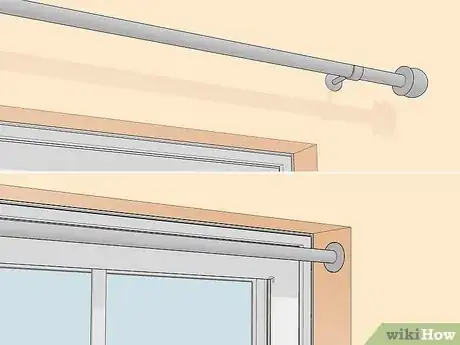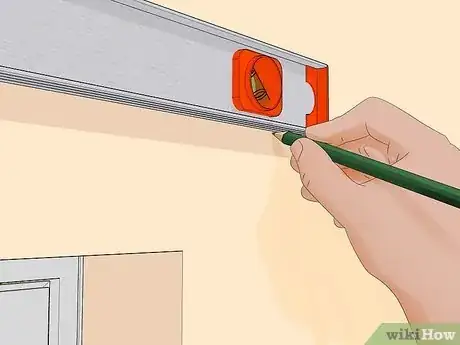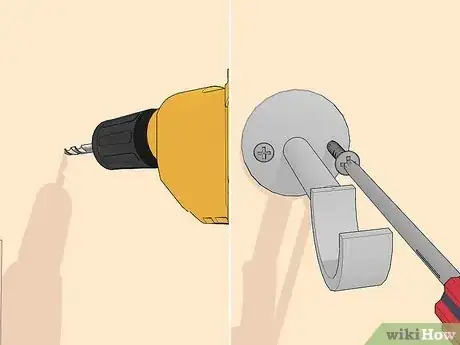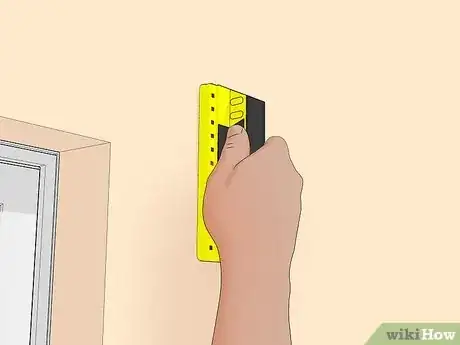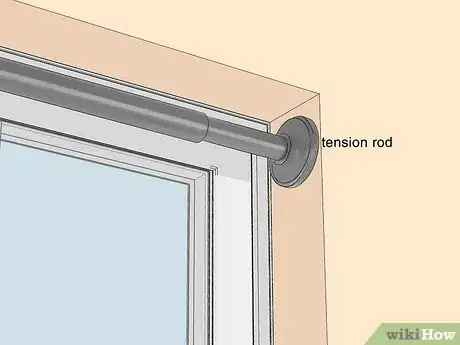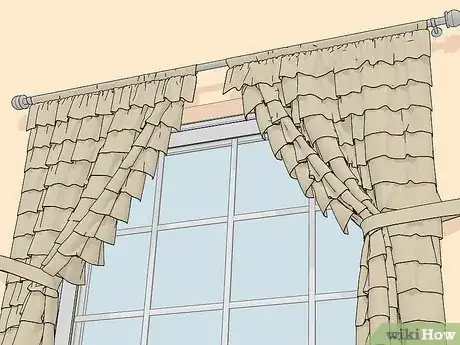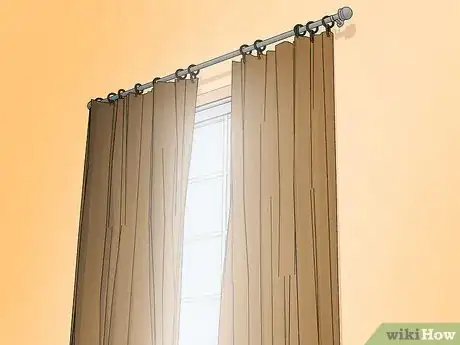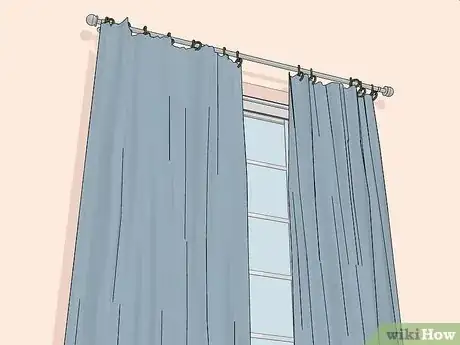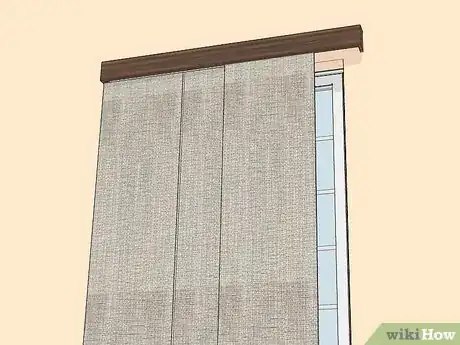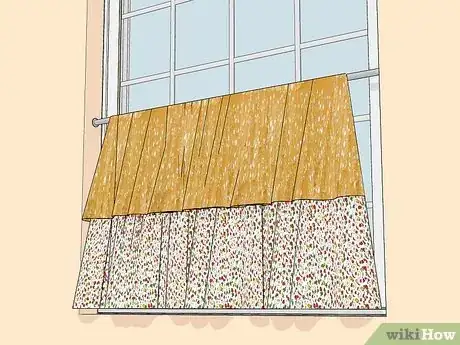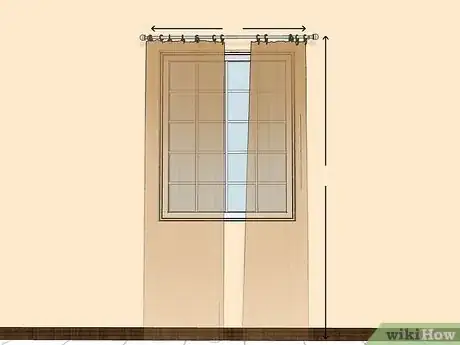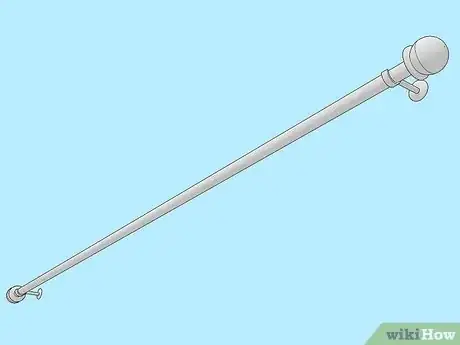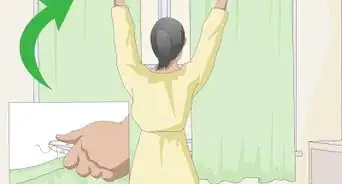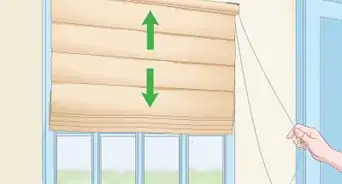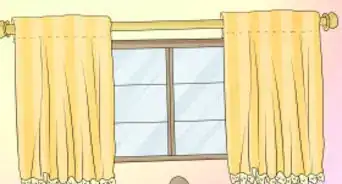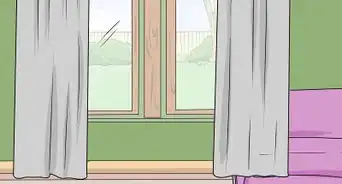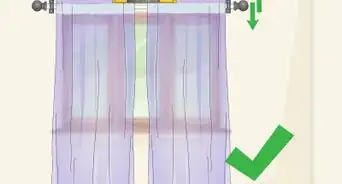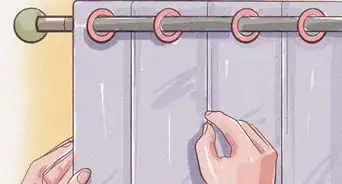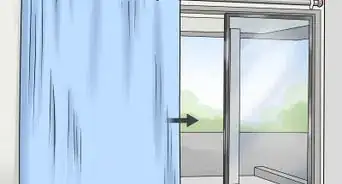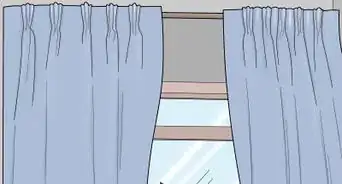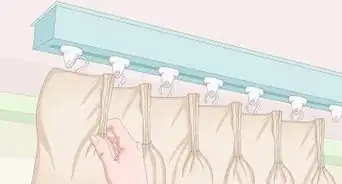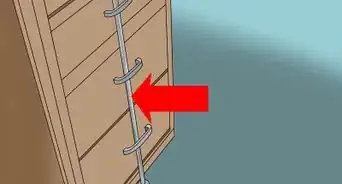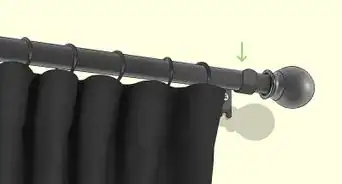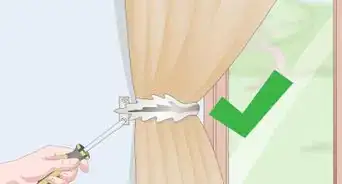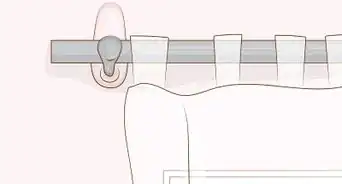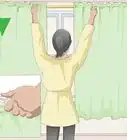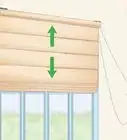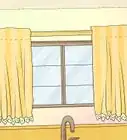This article was co-authored by Karen Parziale and by wikiHow staff writer, Kyle Smith. Karen Parziale is a Home Stager, Home Organizer, and the Founder of The Real Estate Staging Studio based in Hoboken, New Jersey. Karen has over 15 years of home staging and decorating experience and has staged over 5,000 homes. She specializes in project management, space planning, material selections, and builder, architect, and client relationships.
There are 8 references cited in this article, which can be found at the bottom of the page.
This article has been viewed 741,686 times.
It’s tempting to put off hanging your curtains, but believe us when we say the next-door neighbors really don’t want to see you watching Seinfeld in your underwear. It’s time to hang the drapes. It can seem like a daunting task, but installing curtain rods is simple once you know what you’re doing. We’ll show you exactly how to install your curtain rods and hang your drapes to give your home character, shade, and privacy.
Things You Should Know
- Measure your window and mark the locations of your hardware prior to installing your curtain rod.
- Make sure all your measurements are even by using a carpenter's level.
- Install the hardware for your curtain rod about 4 inches (10 cm) above your window and about 3 inches (7.6 cm) out from each side of the window or casing.
Steps
Hanging Your Curtain Rod
-
1Choose whether to install the rod on the casing or the wall outside the casing. Installing in the casing will always leave at least part of the window obscured, while installing outside the casing allows you to pull the curtains back completely. Which you choose will partially be determined by the material of the wall or casing. If you have plastic window casing, the curtain rod will need to be installed on the wall; if you have plaster, cob, or stone walls, then the casing may be easier.[1]
- Bear in mind that the curtain will only draw back as far as the brackets holding the curtain rod, and the style of the curtain will determine how much they can be compressed.
- If you want to install your curtain rod in the wall, make sure to install it in a stud. If you cannot locate a stud or must install the rod in drywall, you will have to use drywall anchors.[2]
-
2Measure your window to make sure your curtains and rods fit. Measure from about 4 inches (10 cm) to 6 inches (15 cm) above your window to the floor to determine the length your curtains should be. To figure out the length of your rod, measure the width of the window, and then add about 8 inches (20 cm) to 12 inches (30 cm).[3]
- Bear in mind that some styles of curtains have ruffles or pleats that extend above the top of the rod; subtract this section from the measurement.
- If you want your room to appear taller, hang your curtains closer to the ceiling to give the illusion of height.
Advertisement -
3Use your pencil and a level to mark where you’ll put your hardware. This is where your bracket and screws will go. Plan to screw your hardware into the wall at the height you determined in the last step, and about 3 inches (7.6 cm) from either side of the window. To get an accurate measurement, hold the bracket in position against the wall with your fingers, and then use your pencil to mark where the screw will go.[4]
- Be careful not to get too close to the edge if installing in the casing, as this will make the material too fragile and cause the wood to crack.
- Adding 3 inches (7.6 cm) on each side of the window will give you as much light as possible when the curtains are drawn.
- Measure for a mid brace if needed. Though most curtain rods are adjustable, you don't want the distance between the brackets to be so wide that the rod sags in the middle. In general, you shouldn't increase the length of the expanded rod by more than 50%.
-
4Drill pilot holes to help start the screws, and then screw the brackets in. Drilling pilot holes before screwing in your hardware can keep the screws from cracking the casing or wall material. If you’re installing the brackets into drywall, make sure your pilot holes are big enough to place screw anchors into; if you're installing into the studs, you won't need anchors.[5]
- Use a stud finder to find the studs in your wall.
- Screw anchors will expand inside the drywall panel to the weight of the rod and curtains and will prevent the screws from pulling out of the wall.
- If you can't screw directly into the wall, or if you want to hang café curtains, use a tension rod instead. Place the tension rod inside the window frame, twist it to unlock it, and let it expand until it is tightly suspended between both interior edges of the window frame.[6]
-
5Hang your curtains. Thread your curtains on the rod, then place the rod on the brackets. How exactly your hang your curtains (for instance, by threading the rod through a pocket in the curtain or by hanging the curtain on pins) will depend on what sort of curtain you're using.[7]
- If you're hanging eyelet curtains, thread the rod through the holes in the top of the curtains. Panel curtains usually have one long pocket sewn into the top that you must push the rod through.
- To hang drapes, place drapery pins in the pleat, and then hang the pins on the rod.
- If hanging tab top curtains, a thin rod is best. A thick rod will draw the curtain up, making it hang too high.
Choosing the Right Curtains
-
1Opt for curtains that match your aesthetic and needs. If you haven’t already chosen your curtains and rods, think about what style of curtain is right for you and your living space: do you want heavy curtains that will block out daylight when they are closed? Or perhaps you prefer curtains that only cover a portion of your window. There are a number of unique styles of curtains to choose from.[8]
- Drapes are typically made from heavy, pleated material and are hung by attaching drapery pins to the pleat and then hanging them on the rod.
- Panel curtains, eyelet curtains, and tab top curtains are meant to hang from a plain round rod. They may have a pocket along the top to push the rod through, or the rod may be threaded through eyelets or tabs.
- Café curtains cover only the bottom half of a window, to let light into the room while affording some privacy. They are typically hung on tension rods.
-
2Measure your window and pick curtains of corresponding length and width. To make sure you get the right sized curtains, measure the length and width of your window, and then decide where you want the bottom of your curtain to fall. Some folks prefer curtains that hit the bottom of the window sill, while others prefer curtains that extend below the sill.[9]
- A general rule of thumb says that you should choose curtains that are 2 times the width of your window. The wider your curtains are, the more they will fold and bunch, while narrower curtains will hang flat. Keep in mind that thinner materials will bunch less, while thicker materials will be fuller.[10]
- If you opt for tab top curtains, make sure the curtain length doesn't include the length of the tabs.
- Floor length curtains should end 1/2 inch (1.25 cm) from the floor, unless you live in a humid environment, in which case they should end 1 inch (2.5 cm) from the floor, because they will stretch more on humid days.
- If your ceiling is low, curtains can give the illusion that your ceiling is higher than it is: opt for long curtains (like drapes or panel curtains), and install the curtain rod closer to the ceiling. Alternatively, don't let your curtains end a few inches above the floor, as this can make your ceiling seem lower.
- Your curtains may extend beyond the floor—a style known as puddling. If you plan to puddle your curtains, measuring is pretty simple: you only need to ensure you have plenty of material left over for the puddle.
- Curtains that hang below the sill should extend 4 inches (10 cm) below the sill, long enough to cover the edge of the casing below the window.
- Sill-length curtains should skim the sill.
-
3Buy a long rod if you want to pull back the curtains completely. A shorter rod is fine if you don't want your window to be completely exposed when your curtains are open. If you'd like to pull them completely away from the window, buy a longer rod or a rod that has a return (a 90-degree turn on each end that allows you to push the curtain around the turn or rest against the wall).[11]
- To determine the length the return should be, measure the width of the curtain.
- Curtains that open completely will give you as much sunlight as possible, but keep in mind that concealing the edge of the windows will give the illusion that your window is bigger than it is.
Expert Q&A
-
QuestionWhere do I buy a curtain rod for a bay window?
 Karen ParzialeKaren Parziale is a Home Stager, Home Organizer, and the Founder of The Real Estate Staging Studio based in Hoboken, New Jersey. Karen has over 15 years of home staging and decorating experience and has staged over 5,000 homes. She specializes in project management, space planning, material selections, and builder, architect, and client relationships.
Karen ParzialeKaren Parziale is a Home Stager, Home Organizer, and the Founder of The Real Estate Staging Studio based in Hoboken, New Jersey. Karen has over 15 years of home staging and decorating experience and has staged over 5,000 homes. She specializes in project management, space planning, material selections, and builder, architect, and client relationships.
Home Stager & Interior Designer Bay window dimensions aren't universal, so you can't just go to store and get one. You have to get them custom made.
Bay window dimensions aren't universal, so you can't just go to store and get one. You have to get them custom made. -
QuestionHow do I hang a curtain rod if I live in an apartment and I can't drill into the studs?
 Karen ParzialeKaren Parziale is a Home Stager, Home Organizer, and the Founder of The Real Estate Staging Studio based in Hoboken, New Jersey. Karen has over 15 years of home staging and decorating experience and has staged over 5,000 homes. She specializes in project management, space planning, material selections, and builder, architect, and client relationships.
Karen ParzialeKaren Parziale is a Home Stager, Home Organizer, and the Founder of The Real Estate Staging Studio based in Hoboken, New Jersey. Karen has over 15 years of home staging and decorating experience and has staged over 5,000 homes. She specializes in project management, space planning, material selections, and builder, architect, and client relationships.
Home Stager & Interior Designer You can always get a tension rod. Just hang it inside of the window frame and then hang the curtain from that. It may not be the most elegant solution in the world, but it will definitely work!
You can always get a tension rod. Just hang it inside of the window frame and then hang the curtain from that. It may not be the most elegant solution in the world, but it will definitely work! -
QuestionI have an older mobile home that has the thin wood paneling. What is the best way to install my curtain rods?
 wikiHow Staff EditorThis answer was written by one of our trained team of researchers who validated it for accuracy and comprehensiveness.
wikiHow Staff EditorThis answer was written by one of our trained team of researchers who validated it for accuracy and comprehensiveness.
Staff Answer wikiHow Staff EditorStaff AnswerFor wood paneling, try adhesive strips and hooks. Many manufacturers offer adhesive curtain rod holders. This is also a great option for people who are renting and not permitted to drill holes in the wall.
wikiHow Staff EditorStaff AnswerFor wood paneling, try adhesive strips and hooks. Many manufacturers offer adhesive curtain rod holders. This is also a great option for people who are renting and not permitted to drill holes in the wall.
Warnings
- Don't hang your curtains so they cover radiators or heat registers.⧼thumbs_response⧽
Things You'll Need
- Curtain rod
- Curtains
- Brackets
- Tension rod (if needed)
- Screws
- Screw anchors (if needed)
- Screwdriver
- Stud finder
- Drill
- Measuring tape
- Carpenter's level
- Pencil
- Small nails or brads
- Hammer
- Stepladder
References
- ↑ Karen Parziale. Home Stager & Interior Designer. Expert Interview. 30 June 2021.
- ↑ https://heyletsmakestuff.com/hang-curtains-quick-tutorial/
- ↑ https://www.architecturaldigest.com/story/how-to-hang-curtains
- ↑ https://onelittleproject.com/how-to-install-a-curtain-rod/
- ↑ https://www.architecturaldigest.com/story/how-to-hang-curtains
- ↑ Karen Parziale. Home Stager & Interior Designer. Expert Interview. 30 June 2021.
- ↑ https://www.architecturaldigest.com/story/how-to-hang-curtains
- ↑ https://www.homestratosphere.com/types-curtains/
- ↑ https://www.curbly.com/curtain-lengths
About This Article
Before installing a new curtain rod, take some measurements to make sure you’re putting it in the right place. For instance, if you want to install floor-length curtains that are 96 inches (243.8 cm) long, you’ll need to put the rod 96 inches (243.8 cm) above the floor. You’ll also need to take into account how far you want the curtains to extend on either side of the window frame, since this will help you determine where to attach the brackets for the rod. If you’re installing a really wide curtain rod—for example, over a picture window—you might also want to add a middle support bracket halfway between the two main brackets. Make marks on the wall with a pencil where you want the brackets to go, then check that they’re even with a laser level. Once you’re satisfied that they’re lined up correctly, hold the brackets in place and insert a pencil into the screw holes to mark where the screws will go. Drill pilot holes into the wall or window casing at each spot where you will be putting in a screw. If you’re installing the brackets in drywall rather than in a wall stud, drive in screw anchors to ensure that the curtain rod stays securely in place. Line the brackets up over the pilot holes and screw them in. Insert the rod into the brackets and use a carpenter’s level to double check that it’s sitting correctly. If it’s not, you may need to adjust the placement of the brackets. Finally, remove the rod and hang your curtains on it, then replace the rod between the brackets. For tips on what kind of rods to use with different types of curtains, keep reading!
